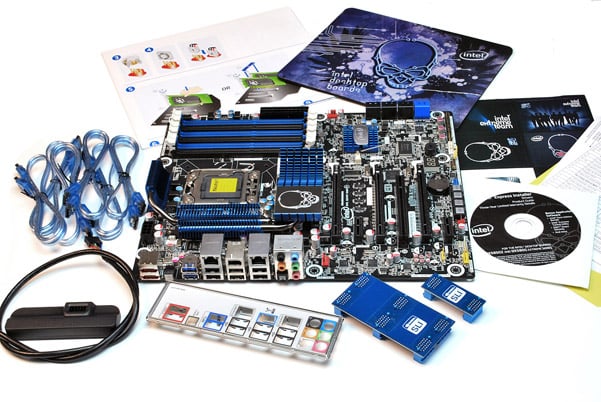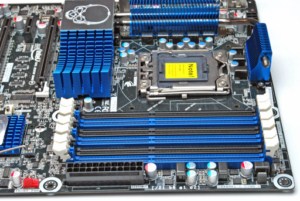Intel Core i7-990X Extreme: Crazy Fast Got Faster
Intel's DX58SO2 Motherboard and Test Systems
|

Intel's DX58SO2 "SmackOver 2" Motherboard - The kit has it all and then some.






There are three full-length PCIe X16 slots on the board, a PCIe X1 slot and a standard PCI slot. We say do away with that remaining PCI slot and add another X16 or perhaps a X8 PCIe slot. Other creature comforts include a "Back to BIOS" button on the back IO panel. It lights up red when it's pushed in and will take you immediately back to the BIOS if you dial up a configuration while tweaking or overclocking, that won't boot. Very nice touch, Intel. Also, take note of the power-on, reset and "clock bump" buttons (second row, right hand shot) on the board. If you hit one of the plus or minus buttons, it will bump clock speeds up or down by 1MHz. Again, Intel obviously has a renewed focus on the enthusiast and it shows. On a side note, though we're not showing screen shots here, the BIOS of the DX58SO2 is also well designed with copious amounts of tweakability under the hood, enough really for pretty much anything you'd want to configure for performance tuning purposes.
Finally, here's a quick scan of the rest of our test systems that we'll be comparing versus the new Intel Core i7-990X Extreme Edition processor.
Test System Configuration Notes: When configuring our test systems for this article, we first entered their respective system BIOSes and set each board to its "Optimized" or "High performance Defaults". We then saved the settings, re-entered the BIOS and set memory timings for either DDR3-1333 with 8,8,8,24 timings. The hard drives were then formatted, and Windows 7 Ultimate x64 was installed. When the Windows installation was complete, we updated the OS, and installed the drivers necessary for our components. Auto-Updating and Windows Defender were then disabled, finally, we installed all of our benchmarking software, performed a disk clean-up, defragged the hard drives, and ran all of the tests.
|
| System 1: Core i7-970 (3.2GHz - Six-Core) Core i7-980X (3.33GHz - Six-Core) Core i7-990X Intel DX58SO2 Motherboard (X58 Express Chipset) 3x2GB Kingston DDR3-1333 (@ 1333MHz, CAS 8) GeForce GTX 280 On-Board Ethernet On-board Audio WD150 "Raptor" HD 10,000 RPM SATA Windows 7 x64 |
System 3: Core i7-2600K (3.4GHz - Quad-Core) Core i5-2500K (3.3GHz - Quad-Core) Intel DH67BL, DP67BG (P67 Express Chipset) 2x2GB Patriot DDR3-1866 (@ 1333MHz, CAS 8) GeForce GTX 280 On-Board Ethernet On-board Audio WD150 "Raptor" HD 10,000 RPM SATA Windows 7 x64 |
System 3: Core i7 Extreme 975 (3.33GHz - Quad-Core) Gigabyte EX58-UD5 (X58 Express Chipset) 3x2GB OCZ DDR3-1333 (@ 1333MHz, CAS 8) GeForce GTX 280 On-Board Ethernet On-board Audio WD150 "Raptor" HD 10,000 RPM SATA Windows 7 x64 |
System 4: Core i7 870 (2.93GHz - Quad-Core) Core i5 750 (2.66GHz - Quad-Core) Asus Maximus III Formula (P55 Express Chipset) 2x2GB Kingston DDR3-1600 (@ 1333MHz, CAS 8) GeForce GTX 280 On-Board Ethernet On-board Audio WD150 "Raptor" HD 10,000 RPM SATA Windows 7 x64 |
System 5: AMD Phenom II X4 965 (3.4GHz Quad-Core) Asus M4A79T Deluxe (AMD 790FX Chipset) 2x2GB Kingston DDR3-1600 (@ 1333MHz, CAS 8) GeForce GTX 280 On-Board Ethernet On-board Audio WD150 "Raptor" HD 10,000 RPM SATA Windows 7 x6 |






